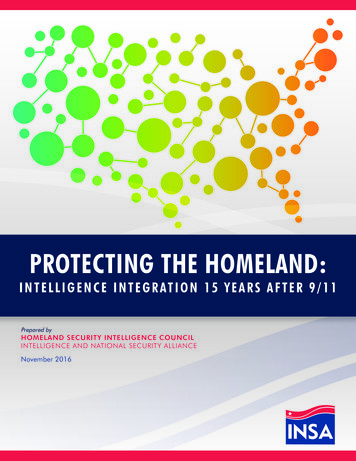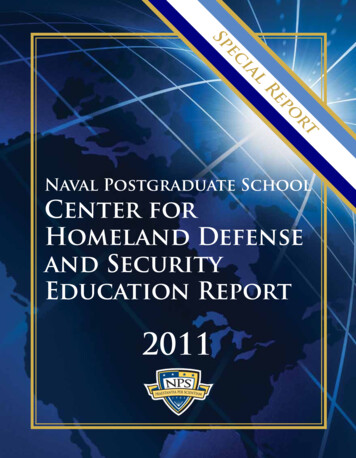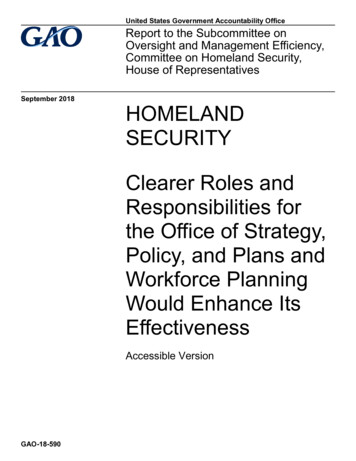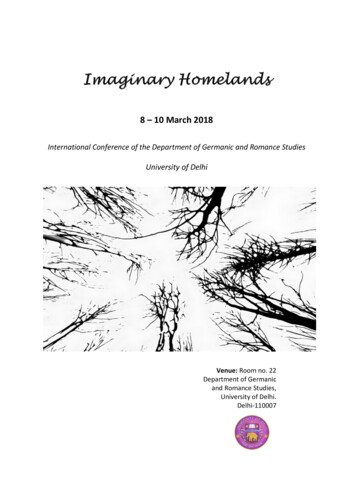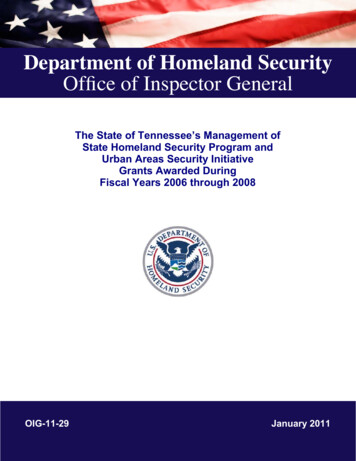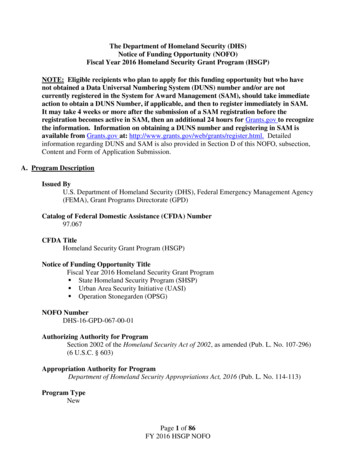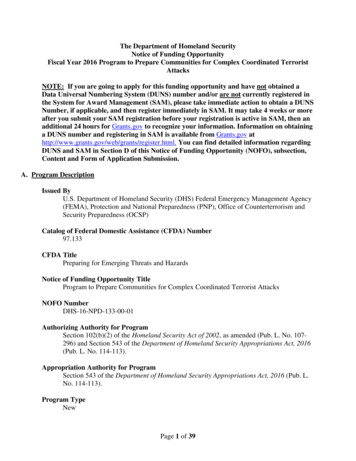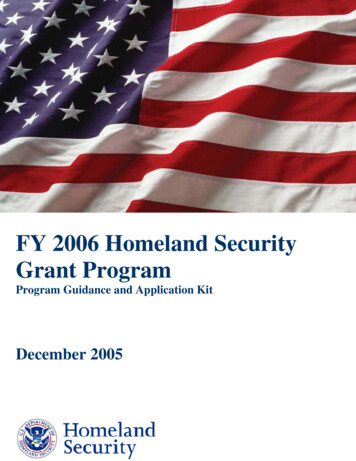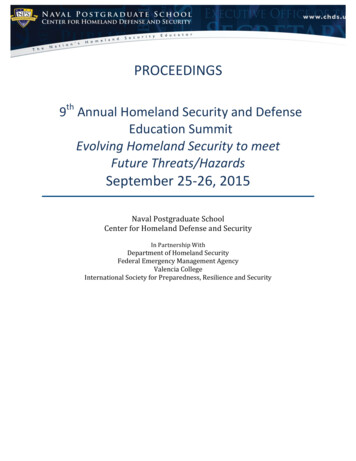
Transcription
PROCEEDINGS9th Annual Homeland Security and DefenseEducation SummitEvolving Homeland Security to meetFuture Threats/HazardsSeptember 25-26, 2015Naval Postgraduate SchoolCenter for Homeland Defense and SecurityIn Partnership WithDepartment of Homeland SecurityFederal Emergency Management AgencyValencia CollegeInternational Society for Preparedness, Resilience and Security
Table of ContentsTable of Contents1Summit Agenda2Evolving Homeland and Civil Security Mission Space and Research – A Crossdisciplinary and Global Challenge.Alexander Siedschlag9The Socio-Behavioral Response of Survivors to Campus Active Shooting EventsMark Landahl13The Graphic Novel: A Cool Format for Teaching Homeland SecurityJohn Comiskey16Airmanship on the Ground: How the Aviation Industry can FundamentallyChange the Way First Responders Manage Complex EmergenciesRyan Fields-Spack19Homeland Security: Online Education Models for Mass Trauma InterventionIntegrated PedagogyRudolph R. BustosPatricia A. Levy22Mentoring Terrorism Offenders in the United KingdomDouglas Weeks24Walking on Eggshells: Teaching Terrorism Studies in a Politically Correct WorldBlake D. DeVolld26Border Porosity: Reviewing the Past Five YearsJames Phelps, Mark Pullin, Monica Koenigsberg, , Cliff Crumley, Amil Imani29The Applied Learning Environment: Using Simulation Cells for Graduate Studiesin Emergency Management and Homeland SecurityMeghan McPherson31The Making and Blending of a New Emergency Management/Homeland SecurityBachelor of Applied Science Degree: How and WhyDarryl Cleveland33Organized Threats to School Security: Protecting Schools Beyond the Lone WolfActive ShooterWilliam M. Toms351
Summit AgendaFriday, September 257:30 - 8:00am8:00 - 8:15Event Registration and Check-inWelcome RemarksStanley SupinskiCo-Director, University and Agency Partnership InitiativeJames McDonaldDean, Career and Technical ProgramsValencia College8:15 – 9:15Keynote AddressKatie FoxDeputy Assistant Administrator, National Preparedness DirectorateFederal Emergency Management Agency9:20 – 10:30Higher Education Issues UpdateScott Kelberg, FEMA/NTED(National Training and Education System)Chris Martin, 2015 INSPRS Update(International Society for Preparedness, Resilience & Security)10:30 – 10:45BREAK10:50 – 11:50Unmanned Aircraft Systems: A Resource for Public SafetyDavid MortonFormer: Federal Aviation Administration Safety Inspector andNational Law Enforcement Program Manager, UAS Integration OfficeIndependent UAS Consultant12:00 – 1:00pmLunch – Informal discussions and networkingConcurrent Break-Out Sessions2
Track One – Evolving the Homeland Security Academic Discipline1:00 – 1:45Homeland Security: An Academic DisciplineJoseph Ryan, Pace University1:45 – 2:30Evolving Homeland and Civil Security Mission Space andResearch – A Cross-disciplinary and Global ChallengeAlexander Siedschlag, The Pennsylvania State University2:30 – 3:15“Human Aspects” in Homeland Security EducationGreg Moore, Notre Dame College3:15 – 4:00Applied Learning Environment: Using a Situation Cell forGraduate StudiesMeghan McPherson, Adelphi University4:00 – 4:45Beyond Discussion Boards: Integrating Interactive OnlineDelivery MethodsMagdalena Denham, Sam Houston State UniversityTrack Two – Issues in Critical Infrastructure and Cybersecurity1:00 – 1:45Breaching the Bundestag: A Preliminary Analysis of thePolicy Response to the Spring 2015 Cybersecurity Incidentat the German ParliamentChristine Pommerening, George Mason University1:45 – 2:30Deterrence and Violence in the Cyber DomainStanley Supinski, Center for Homeland Defense and Security2:30 – 3:15The Private Sector and Cyber AttacksHarvey Kushner, Long Island University3:15 – 4:00Hold4:00 – 4:45HoldTrack Three – Applied Homeland Security: Lessons from Practice1:00 – 1:45Emergency Management, a Collaborative Endeavor: ActiveShooter Exercise Example3
Don Mason, Rio Hondo College1:45 – 2:30Examining Unmanned Aerial System Threats: ConceptualAnalysisJon Loffi, Oklahoma State UniversityRyan Wallace, Polk State College2:30 – 3:15The Need for Unity of Command from the Planning Phaseto ExecutionRichard Rosell, Indian River Shores Department of Public Safety3:15 – 4:00Aviation Terrorism and the First ResponderJohn Fisher and Janel Mitchell, Utah Valley University4:00 – 4:45Airmanship on the Ground: How the aviation industry canfundamentally change the way first responders managecomplex emergencies.Ryan Fields-Spack, Aurora Colorado Office of Emergency ManagementTrack Four – New Approaches in Homeland Security Education1:00 – 1:45Making and Blending of a New EmergencyManagement/Homeland Security Bachelor of AppliedScience Degree: How & WhyDarryl Cleveland, Truckee Meadows Community College1:45 – 2:30The Graphic Novel: A Cool Format for Teaching HomelandSecurity to Generation YJohn Comiskey, Monmouth University2:30 – 3:15See You at Disney World! Adventures in Homeland SecurityProgram & Course Content Development with DisneyWorld as the VenueMichael Wallace and Rebecca Rouse, Tulane University3:15 – 4:00Fire Service Higher Education: Where Does HomelandSecurity Incorporate?Randall Hanifen and Larry Bennett, University of Cincinnati4:50 – 5:00Day One Wrap-UpStanley SupinskiNaval Postgraduate School, Center for Homeland Defense and Security4
Summit AgendaSaturday, September 267:30 - 8:00amEvent Registration and Check-in8:00 – 8:05Opening Comments/Administrative NotesStanley SupinskiCo-Director, University and Agency Partnership InitiativeCenter for Homeland Defense and SecurityNaval Postgraduate School8:10 – 9:10Panel: Cybersecurity, Information Assurance, and PrivacyModerated by: Bert Tussing, U.S. Army War CollegeMarty Smith, Department of Homeland Security, Protective SecurityRoslyn Torella, Deputy CISO, Social Security AdministrationColonel Jon Brickey, Cybersecurity Center, U.S. Military Academy9:15 – 10:15Inside The Situation Room: Crafting a White HouseStrategy and a Look Back at the Obama AdministrationAfghanistan and Pakistan Strategic ReviewJohn TienFormer Senior Director for Afghanistan and Pakistan, NationalSecurity Council Staff, The White HouseManaging Director, CitiGroupDiscussant: Mike McDaniel, Cooley Law School10:15 – 10:30BREAKConcurrent Breakout Sessions Day 2Track One – Applied Homeland Security: Lessons from Practice10:30 – 11:15Organized Threats to School Security: Protecting SchoolsBeyond the Lone Wolf-Active ShooterWilliam Toms, Fairleigh Dickinson University11:15 – 12:00Assessing the Perceived Effectiveness of Game-BasedLearning in a Homeland Security Curriculum5
Keith Cozine, St. John’s UniversityTrack Two – Security and Civil Liberties10:30 – 11:15Has the Court Moved Too Far From Reasonableness?Keith Logan, Kutztown University11:15 – 12:00Herbert Yardley, the American Black Chamber, and CivilLiberties: Lessons for TodayWilliam Lahneman, Embry-Riddle Aeronautical UniversityTrack Three – Terrorism: Trends and Challenges10:30 – 11:15W alking on Eggshells: Teaching Terrorism Studies in aPolitically Correct W orldBlake DeVolld, Liberty University11:15 – 12:00Teaching Terrorism: Strategy for Engaging StudentsJames “Buster” Hall, Northeastern State UniversityTrack Four – Leadership in Homeland Security10:30 – 11:15Crisis Leadership: Preparations, Relations, andPerceptionsBert Tussing, U.S. Army War College11:15 – 12:00Developing a Leadership Toolbox for Aviation SecurityField Management:The Case for Objective Measures ofPerformance at the CheckpointDale Palmer, Transportation Security Administration12:00 – 1:00LUNCH – Informal discussions and networkingConcurrent Breakout Sessions Day 2Track One – Applied Homeland Security: Lessons from Practice1:15 – 2:00The Socio-Behavioral Response of Survivors to CampusActive Shooter EventsMark Landahl, Mid-Atlantic Center for Emergency ManagementFrederick Community College6
2:00 – 2:45Model Solution to Agencies for Securing EmergencyResponse Vehicles with engineering (SERVE)Michael Johansmeyer, Seminole County Fire Department2:45 – 3:30Cooperation Between Nonprofit Organizations andGovernmental Agencies During Disaster Management: Notso Equal PartnersEdin Mujkic and Lauren Brengarth, University of Colorado ColoradoSpringsTrack Two – Cybersecurity, Intelligence and Civil Liberties1:15 – 2:00Benefits and Perils of Domestic UAV UseAnna Holyan, Westminster College2:00 – 2:45Ensuring Systemic Resiliency to Manage Catastrophic RiskMichael Barrett, Center for Homeland Security and Resilience2:45 – 3:30Mentoring Terrorist Offenders in the UK: Mentors,Offenders, and StructureDouglas Weeks, London Metropolitan UniversityTrack Three – Terrorism: Trends and Challenges1:15 – 2:00ISIS Threat in the BalkansJohn Fisher, Utah Valley UniversityMuhaedin Bela, Macedonian Department of National DefenseVesna Pavicic, Bosnia-Herzegovina Department of National Security2:00 – 2:45Countering Violent Extremism: Challenges for the U.S.GovernmentEhsan Zaffar, Department of Homeland Security2:45 – 3:30Border Porosity: Reviewing the Past Five YearsJames Phelps, Monica Koenigsberg, Mark Pullin, Cliff Crumley, andAmil Imani, Angelo State UniversityTrack Four – Special Topics1:15 – 2:00Teaching Ethics in HD/HS and EM ProgramsArthur Liberty, Boston University7
2:00 – 2:45Network Regional Strategy – Creating a Realistic andViable Homeland Security Strategy at the Regional andLocal LevelsMichael Andreas, Endicott College2:45 – 3:30Homeland Security: Online Educational Model for MassTrauma InterventionRudolph Bustos, Trident UniversityPatricia Levy, Fort Hays State UniversityReturn to Plenary Session3:45 – 4:30Emergency Management and Homeland Security:Considerations for the FutureBryan KoonDirector, Florida Division of Emergency Management4:30 – 4:45Closing Comments and Wrap-UpStanley SupinskiCo-Director, University and Agency Partnership Initiative4:45ADJOURN8
Papers & PresentationsEvolving Homeland and Civil Security Mission Space and ResearchA Cross-disciplinary and Global ChallengeAlexander Siedschlag, Ph.DDistinguished ProfessorThe Pennsylvania State UniversityExecutive SummaryHomeland security has evolved from a governmental function to a networked community withshared responsibility for addressing all-hazards challenges to globalized societies, moving froman ‘Americanized’ term to a generic concept. It aims at ensuring civil security – a broader effortnot geographically, culturally, or functionally bound. The paradigm of civil security researchprovides an insightful framework for research and teaching in homeland security as part of aglobal and holistic effort, calling for a cross-disciplinary perspective.Homeland Security as a Functional PolicyHomeland security today represents a functional policy area found in different countries,although its institutional setup in the U.S. is still singular.1 However, U.S. homeland security hasincreasingly focused on broader functional aspects of the mission space. Definitions haveevolved: from homeland security as “a concerted national effort to prevent terrorist attacks within theUnited States, reduce America’s vulnerability to terrorism, and minimize the damage andrecover from attacks that do occur;”2over additionally addressing the “full range of potential catastrophic events, including manmade and natural disasters;”3to homeland security as the “intersection of evolving threats and hazards with traditionalgovernmental and civic responsibilities for civil defense, emergency response, lawenforcement, customs, border patrol, and immigration.”4An “enterprise” beyond a governmental function exerted through DHS,5 homeland security, itsenduring core missions, and risk-informed priorities involve international, transnational, and1Cf. Morag, N. (2011). Comparative Homeland Security: Global Lessons. Hoboken, NJ: Wiley.The President of the United States, Homeland Security Council (2002). National Strategy for Homeland Security.Washington, D.C.: The White House, viii. Retrieved from s/natstrat-hls-2002.pdf3The President of the United States, Homeland Security Council (2007). National Strategy for Homeland Security.Washington, D.C.: The White House, 3. Retrieved fromhttp://www.dhs.gov/xlibrary/assets/nat strat homelandsecurity 2007.pdf4U.S. Department of Homeland Security (2010). Quadrennial Homeland Security Report: A Strategic Frameworkfor a Secure Homeland. Washington, D.C., 12. Retrieved ations/2010-qhsr-report.pdf5U.S. Department of Homeland Security (2010), 8.29
potentially global reach and interdependency in addition to their national (meaning nation-wideas opposed to nation-only) and whole community scope. Examples include the counterterrorismcontinuum, the cyber dimension, the emphasis on working with international partners, and theemphasis on homeland security governance, coordinating the risk managing efforts of a“networked community.”6U.S. Homeland Security as Part of a Pluralistic Security CommunityA security community is a socially constructed, “cognitive” region, characterized by “sharedidentities, values, and meanings,”7 whose borders do not typically coincide with traditionalgeographical borders.8 DHS terminology suggests that the “homeland security community” canbe regarded as a security community, as it is “flexible, adaptable, and efficient in addressingdiverse challenges if it acts as an integrated, mutually supporting network.”9 Securitycommunities also promote “security and risk reduction approaches that are responsive to theneeds of our partners.”10From a security community perspective, nations need to work together to realize homelandsecurity as a common good, geared to repelling threat to each nation’s and security community’scommonly acquired values.11 U.S. homeland security being an enterprise, society is an activepartner in the creation and delivery of security as a common good, not just a recipient of thatgood. Societal security efforts to safeguard commonly acquired values should itself be guided bythose values, and not acquire a potential to infringe upon them. Those aspects are part of achallenge that relates to ethical, legal, and social implications, known as ELSI. It warrantscritical thinking rooted in cross-disciplinary and global perspectives.The Civil Security PerspectiveNowadays, homeland security has evolved into a generic concept.12 It is best understood as apluralistic endeavor rooted in civil security research, that is, a multidisciplinary and internationalenterprise of study contributing to a scientific basis for homeland security efforts, drawing fromacross disciplines.13 This includes using the wealth of resilience supporting knowledge acquiredby national security, civil defense, internal security and disaster research during decades prior to9/11.14 Civil security reflects that in our globalized societies, security risks and crises are global,678Cf. U.S. Department of Homeland Security (2014). The 2014 Quadrennial Homeland Security Review.Washington, D.C., 14. Retrieved from s/2014-qhsr-final-508.pdfAdler, E., & Barnet, M. (1998). Security Communities. Cambridge: Cambridge University Press.Bellamy, A. J. (2004). Security Communities and Their Neighbours: Regional Fortresses or Global Integrators?New York: Palgrave Macmillan.9U.S. Department of Homeland Security (2014), 31.Ibid.11Drawing from Arnold Wolfers’ classic definition of national security, see Wolfers, A. (1952). “National security”as an ambiguous symbol. Political Science Quarterly 67, 481-502.12Cf. Amass, S. F. et al., eds. (2006). The Science of Homeland Security. West Lafayette, ID: Purdue UniversityPress; Bourne, M. (2014). Understanding Security. Houndmills, Basingstoke: Palgrave Macmillan; Voeller, J. G.ed. (2010). Wiley Handbook of Science and Technology for Homeland Security. Hoboken, NJ: Wiley.13Cf. Gill, M. ed. (2014). The Handbook of Security (2nd ed.). Basingstoke: Palgrave Macmillan; Siedschlag, A., ed.(2015). Cross-disciplinary Perspectives on Homeland and Civil Security: a Research-Based Introduction. NewYork: Peter Lang; Smith, C. L., & Brooks, D. J. (2013). Security Science: The Theory and Practice of Security.New York: Elsevier.14Dory, A. J. (2003). Civil Security: Americans and the Challenge of Homeland Security. Washington, D.C.: Center1010
spilling over their place of origin and acquiring the potential for global impact, such as in thecyber dimension but also in supply chain, transportation, and other sectors.In homeland security higher education, it is essential to represent different concepts, intellectualstyles, and methodological choices, including a broadening of perspective “from home toabroad.”15 Programs must reflect that “the homeland security mission is a global one, and ahomeland security approach that ends at a nation’s borders is not a homeland security approachat all.”16Teaching to the ChallengeThe test for homeland security higher education programs is to co-evolve with the real-worldmission space without reinforcing or legitimizing securitization at the expense of analytical rigorand critical thinking. 17 We must educate continuing and emerging leaders to be thoughtfulmasters, not willing servants, of the mission space of tomorrow. We do not know which specificdisciplinary perspectives tomorrow’s homeland security requires. What we do know is that it willrequire the ability and willingness to think and act, as well as to teach and learn, acrossprofessions, disciplines, and nations, and around the world.Using the example of Penn State’s Intercollege Master of Professional Studies in HomelandSecurity (iMPS-HLS) program,18 the following table illustrates major dimensions of theeducational/pedagogical value added to homeland security higher education programs by a crossdisciplinary global perspective, informed by civil security research.TABLE 1. Online Pedagogical Effectiveness Added Value of Teaching Homeland Security inCross-disciplinary and Global st vs.ConstructivistLearning TheoryBehavioral vs.EffectivenessIndicatorConstructivist andlearner centeredapproachesThoughtful matchesCourseImplementationAssignments thatsupporttransformativeunderstanding of thesubject matter acrossjurisdictions,countries, and culturesScenario foresightfor Strategic and International Studies.Newsome, B. O., & Jarmon, J. A. (2015). A Practical Introduction to Homeland Security and EmergencyManagement: From Home to Abroad. Los Angeles, CA: Sage (CQ Press).16Morag, N. (2011), 362.17Balzacq, T., ed. (2011). Securitization Theory: How Security Problems Emerge and Dissolve. London and NewYork: Routledge.18Penn State World Campus: Online homeland security graduate programs. http://www.worldcampus.psu.edu/hls19The table is based on selected parts of the “Online pedagogical effectiveness framework,” see Kidd, T. (2009).Online Education and Adult Learning: New Frontiers for Teaching Practices. Hershey, PA and New York, NY:Information Science Reference, 25.1511
CognitiveCultural SensitivityTask OrientationInsensitive vs.RespectfulAcademic vs.AuthenticSource MotivationExtrinsic vs. IntrinsicStructural FlexibilityFixed vs. Openbetween materials,learning styles, andlearning contextsstudies and table topexercises requiringreconciliation ofdifferent information,leadership styles,professional mindsets,as well as operationalcodes and contextsAssignments areLearning experiences focused on workingthat encouragewith internationalsynthesis andpartners, acrossanalysis; opportunities cultures; case andfor deep learningscenario repositoriesfor use across coursesEngagement in online Online policy sourcesmaterialsand real-world toolsfor analysis fromother countries thenthe U.S. are used, forexample as developedin security researchgrants projectsHigh quality materials International casedesign; range ofstudy repositories;navigational choices;slots for dynamicopen jaws to allow for learning ‘nuggets,’limited coursesuch as videos, and/orchange/adaptationlive online sessionswithout instructionalwith internationaldesign effort or course experts; Internationalrevision proceduresTrack available as anrequiredemphasisThe iMPS-HLS program, sponsored by six colleges, by its very nature fosters a crossdisciplinary perspective, and the available options per definition have a global perspective:biosecurity, geospatial intelligence, information security and forensics, and public healthpreparedness. A common core curriculum where all students in the program work together acrossthe boundaries of academic specializations supports students in developing interoperability ofminds and reflective interaction capacity as members of an evolving international community ofscholar-practitioners.12
The Socio-Behavioral Response of Survivors to Campus Active Shooting EventsMark LandahlSgt., Ph.D., CEM Frederick Community CollegeFrederick County Sheriff’s OfficeExecutive SummaryThis presentation reviews a study of survivor behavior during campus active shooting events thatemploys a qualitative inductive design using grounded theory methodology within a multiplecase study strategy. The findings across the cases of the Louisiana Technical College and CaseWestern Reserve University shootings develop an Active Shooter Behavioral Response Modelthat traces the actions of survivors. The findings show an absence of panic behavior, butevidence of information seeking behavior, and division of labor and helping behavior amongsurvivors.IntroductionAmerican college campuses have repeatedly shown their vulnerability to active shooter events.In the U.S., 21 million students attend more than 4,500 degree-granting institutions that employnearly 3.7 million faculty and staff.1 Research suggests that active shooter events are increasingin both frequency and lethality.2 The focus of this study is on the actions of victims and survivorsin the seconds and minutes following the commencement of a campus attack. It examines theimmediate aftermath and resultant actions, interactions, and behaviors in sociological terms. Thegoal of this research is to catalog behaviors in order to inform policy development uponempirical findings of human behavior in actual active shooting events. The following researchquestions guide the study:1. What are the processes involved in collectively defining the socio-behavioralresponse to ASEs?2. How do social interactions and social organization emerge among survivors in acampus ASE?3. What type of protective behaviors do survivors of campus ASE exhibit?4. How do decisions for protective behavior arise among survivors in ASE?MethodsThe study has a qualitative inductive design that uses grounded theory methodology3 within amultiple case study strategy.4 The research uses secondary data available under freedom ofinformation laws in the respective states. The cases include the shooting incidents at CaseWestern Reserve University in Cleveland, OH and Louisiana Technical College in Baton Rouge,1Snyder, T. D., and Dillow, S. A. (2012). Digest of education statistics 2011 (NCES 2012-001). National Center forEducation Statistics, Institute of Education Sciences, U.S. Department of Education. Washington, DC.2See several sources including: Blair, J. & Schweit, K. (2014). A study of active shooter incidents in the UnitedStates between 2000 and 2013. Washington, DC: U.S. Department of Justice.3Glaser, B. & Strauss, A. (1967). The discovery of grounded theory. Chicago: Aldine: Publishing.4Yin, R. (2014). Case study research: Design and methods. Fifth Edition. Thousand Oaks,CA: Sage Publications.13
LA. Data sources include police reports, 9-1-1 call recordings, written witness statements,recordings of interviews by detectives, police radio recordings, court documents, media reports,and site visits by the researcher. The researcher used NVivo 10 software to assist in dataanalysis.Research Questions and Propositions from the LiteratureA unified body of knowledge on active shooter events does not exist.5 As a result, the study usesfindings from a wide body of disaster research on other event types as a proxy. These eventsinclude fires, terrorist bombings, explosions, maritime disasters, and crowd disasters. Many ofthese studies of disaster use the Emergent Norms Theory (ENT) as a theoretical basis to examinehuman behavior.6 The core set of five studies of the same event, the Beverly Hills Supper ClubFire, use similar methods and data to this study to examine human behavior during the fire.7Analysis of the findings of these and the nine other event based studies develop severalpropositions from the literature related to the research questions. Generally, these studies showconsistent behaviors among victims and survivors that are contrary to popular myths of humanbehavior in disaster.8FindingsThe results of the analysis confirm the propositions from the literature and show that humanbehavior in response to active shooter events is generally consistent with that of other disasterevent types. The study advances four core findings:o Finding 1. The survivor response to campus active shooter events is social rather thanasocial and includes helping behavior between survivors consistent with research findings inother disaster event types.o Finding 2. Survivors of active shooter events will process environmental cues, social cues,and engage in social interaction to define the situation, gather information and implement andreassess protective behavior choices within a framework that maintains and extends socialand organizational roles.o Finding 3. Survivors gather additional information and process environmental cues, socialobservations, and social interactions to determine protective action behaviors that includetaking cover on the floor, running to evacuate, running to shelter, hiding, using availableresources to barricade themselves, locking doors, turning off lights, and barricading doors.o Finding 4. Survivors show group level interaction for confirmation of environmental cuesand processing of additional incident cues that lead to implementation and reassessment ofprotective actions many times with a division of tasks amongst the group (Emergent SocialStructure).5Muschert, G. (2007). Research in school shootings. Sociology Compass, 1: 60-80.Turner, R. & Killian, L. (1987). Collective Behavior. Third Edition. Englewood Cliffs, NJ: Prentice Hall.7Five studies examine the event including the classic work: Johnson, N. (1988). Fire in a crowded theater: Adescriptive investigation of the emergence of panic. International Journal of Mass Emergencies and Disaster, 6, 726.8See Tierney, K. (2003). Disaster beliefs and institutional interests: Recycling the disastermyths in the aftermath of 9-11. Research in Social Problems and Public Policy, 11, 33-51.614
The modeled data from the two cases also fits into the ENT theoretical orientation. Thisprovides further support to ENT as the theoretical basis for understanding behavior in disasterevents with consideration for ecological factors.15
The Graphic Novel: A Cool Format for Teaching Homeland SecurityDr. John Comiskey, Ph.DDistinguished ProfessorMonmouth UniversityHomeland Security higher education is about preparing students for the field. That endeavorinvolves identifying what homeland security is and how the discipline came to be. Foundationaldocuments and especially The National Commission on Terrorist Attacks (9/11 Commission) arecritical to understanding the historical underpinnings of homeland security. Considering the stateof higher education, teaching the 9/11 Commission to first-year college students can be adaunting challenge. According to The National Center for Public Policy and Higher Education(2010), nearly 60 percent of all U.S. first-year college students are not ready for postsecondarystudies. This mixed methods study analyzed the use of a graphic novel version of theCommission’s report, The 9/11 Report: A Graphic Adaptation to help overcome that challenge.The study begins with a brief description of graphic novels. It continues with an explanation ofhow the researcher used the graphic novel in an undergraduate Introduction to HomelandSecurity course. What follows is a methodology section that describes the course’s primaryassignment, a reaction paper and how the paper and a related assignment were assessed. As thisis a part of the UAPI’s 2015 Conference Proceedings, the summary presented here is brief anddoes not include all facts and circumstance related to the study.Graphic novels are a medium that communicate through images, words, and sequence. Baetansand Frey (2015) described graphic novels as a medium, the key features of which sit on aspectrum whose opposite pole is the comic book. Graphic novels are a storytelling medium thecontents of which are more adult focused and disposed toward realism. Many graphic novels areautobiographical, documentary, and historical. Criticisms of comic books, the historical ancestoror cousin (depending on who you ask) of graphic novels, ranges from promoting juveniledelinquency, promiscuity, and homosexuality to promoting anti-American activities (Hajdu,2009; Wertham, 1954). Academic concerns about graphic novels include a sense that they do notrequire the rigor of traditional texts (Gans, 2007).The setting for this research is an undergraduate Introduction to Homeland Security coursetaught at a Northeast University. To satisfy the course’s second learning objective, “students willbe able to describe and analyze the historical events that shaped U.S. homeland policy,” theinstructor set out to capture the essence of the 9/11 Commission. Sensing that the text’s 567pages would overwhelm many of the first-year students, the instructor sought an alternativemedium that would satisfy the learning objective. Jacobson and Colon’s (2006) The 9/11 Report:A Graphic Adaptation met the need as it captured, albeit in an unconventional manner,
Naval Postgraduate School Center for Homeland Defense and Security In Partnership With . Stanley Supinski, Center for Homeland Defense and Security 2:30 - 3:15 The Private Sector and Cyber Attacks Harvey Kushner, Long Island University 3:15 - 4:00 Hold 4:00 - 4:45 Hold

